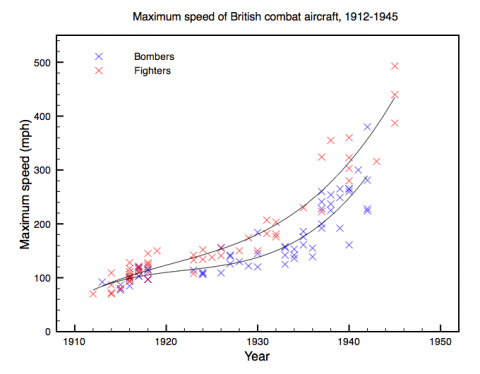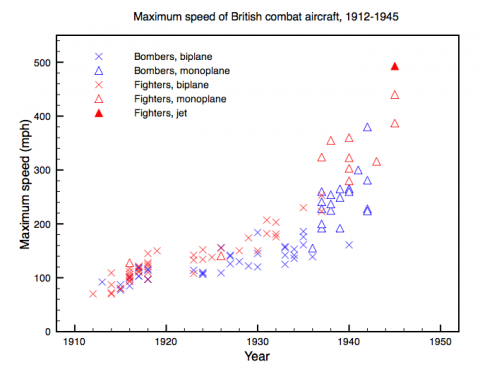Last year I was playing with a plotting program for Mac OS X, which was pretty good, but not quite satisfactory. I’ve found a better one, Plot, which is free (as in beer), fairly easy to use, and very customisable. It has its own idiosyncrasies, but I like it a lot. Here’s an example plot, showing how the top speed of British combat increased up to the end of the Second World War.
The data are drawn from John W. R. Taylor, Combat Aircraft of the World From 1909 to the Present (New York: Paragon, 1979). This excludes aircraft which never saw service as well as those not intended for combat (though not all actually saw combat). The year is that in which it entered service (usually with the RAF), or if this wasn’t given, the year when the prototype first flew. (Some aircraft unfortunately had neither, and so were omitted.) The maximum speeds, in miles per hour, are not necessarily comparable, because they were often obtained at different heights; also, they may not have been sustainable under normal conditions. But they should be broadly indicative of real-world maximums. I’ve classified each aircraft as either fighters (red) or bombers (blue), based upon their actual use. However, that’s fairly arbitrary for the period up to 1915, which is when aircraft adapted for specialised roles began to appear. I haven’t included seaplanes but I have included carrier-borne aircraft. Generally, I have only included data for the most representative version (eg not for each of the innumerable marks of Spitfire). Because of these caveats and inconsistencies, the plot should not be taken too seriously — it’s just for illustrative purposes.
Three things stand out:
- The post-war gap from 1919 to 1923. This was due to the huge surplus of aircraft left over from the war, and the RAF’s rapid shrinkage. It ended in 1923, when the Home Defence Air Force was set in train after scaremongering by Trenchard in Whitehall, and Groves in Fleet Stree, over the French air menace.
- The 1920s saw little improvement in maximum speeds — in fact, the performance of the fastest aircraft in 1918 was not bettered until the end of the decade. It should be remembered, however, that there were many other improvements being made during the 1920s, for example in moving to sturdier airframes, improvements which laid the foundation for the rapid improvements of the 1930s.
- Fighters did not have a marked superiority over bombers in speed until the mid to late 1930s (and sometimes none at all — the Hawker Hart was faster than any British fighter when introduced in 1930). This was one reason for the widespread (though by no means universal) scepticism of the possibility of air defence.
Just for fun, here are 4th-order (cubic) spline fits to the bomber and fighter data, only to illustrate the general trend (I certainly wouldn’t argue they correspond to some underlying law).
There are other performance data in Taylor, which I’ll put up in due course. It would also be interesting to do international comparison (say, between British fighters and French+German bombers), but that will involve a lot more data entry!
Update: I’ve added a few aircraft that I missed initially, and also deleted a bogus datapoint that was dragging down the fit for the bombers. Browser caches may need to be reloaded.
![]() This work is licensed under a Creative Commons Attribution-NonCommercial-NoDerivatives 4.0 International License.
Permissions beyond the scope of this license may be available at http://airminded.org/copyright/.
This work is licensed under a Creative Commons Attribution-NonCommercial-NoDerivatives 4.0 International License.
Permissions beyond the scope of this license may be available at http://airminded.org/copyright/.




Nice charts. I was just talking about the revolution in air power (World History since 1500, after all), and these charts might well find their way into my classroom….
When you have the time, how about amending the chart so that it distinguishes biplanes, monoplanes, and jet aircraft? You’d end up with a handy visual that would illustrate clearly the impact of the monoplane and jet engine “revolutions” on aircraft performance.
Then I could use it when I teach my flight culture class next spring…
Please do feel free to use them for classes! (I’ve never actually said so, but my basic attitude to re-using material I put up here is essentially this.) If you click on them, you’ll get a larger version which would probably look better projected.
That’s a good idea, Scott — I’ll do that when I get a chance! There’s only the one jet on there at the moment, but I could add post-war aircraft too.
Key points: Shift not just from biplane to monoplane, but from braced monoplanes like the Boeing P29/Polikarpov to true, clean structures – the RAF did this in one jump. RR’s development of better and better liquid cooled engines via the Schneider Trophy – good decision to kill the RR Goshawk steam-cooled model.
Interceptor fighter concept – about 1935. Monoplane+Merlin+8 guns. Radar next year.
Yes, moving away from external bracing was a big improvement, but it’s not like braced monoplanes weren’t an improvement themselves. The Boeing P-26 entered USAAC service at the end of 1933, with a top speed in excess of 230 mph. The RAF didn’t have anything that fast until 1935 (Gloster Gauntlet). The Polikarpov I-16 was even faster — over 280 mph. The RAF may have skipped a generation of monoplanes, but it was lucky that it didn’t have to actually fight any in the mid-1930s.
Certainly, the Hurricane and Spitfire were something new for the RAF. But it was not necessarily clear at the time that they were the answer to the problem of the bomber. I’ve read arguments that they needed cannons instead of machine-guns, had their guns synchronised at the wrong ranges, etc. There was some enthusiasm for turret fighters for attacking bombers (ie because it was thought tail-approaching fixed-gun fighters would be easy prey for a bomber’s gunners). And indeed, the RAF itself was hedging its bets, with biplanes (Fury II, Gladiator) being introduced concurrently with the Hurricane, and turret fighters (Defiant) coming in in 1940. Still, I’m sure that the impressive-looking fast monoplane fighters helped increase confidence in air defence. (Not so much radar, which was a secret until 1941 or 1942.)
Pingback: Airminded · Speed 2, the need for more
Pingback: Airminded · The widening margin